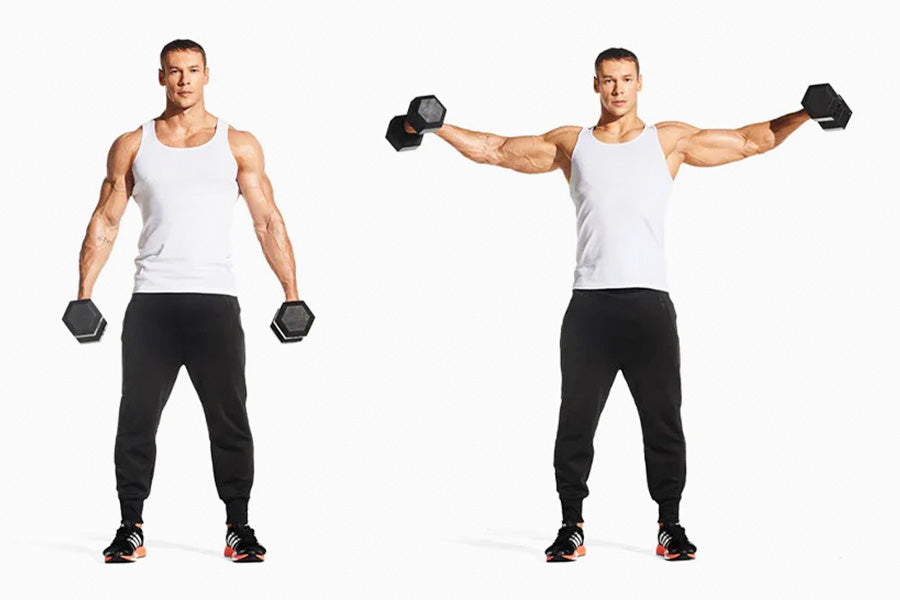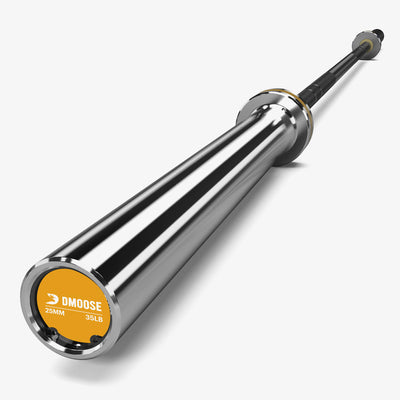Lateral Raise Overview
Exercise Description |
|
Main Target Muscles |
Shoulders |
Secondary Target Muscles |
Upper Back |
Workout Type |
Strength Training |
Gym Gear |
Dumbbells, Barbells, Cable Machine, Bench, Resistance Band |
Fitness Level |
Beginner to Intermediate |
Compound/Isolated |
Isolation |
Power Move |
Pull |
A lateral raise workout, also known as a side delt raise, is one of the most effective isolation exercises for developing shoulder width and definition. It primarily targets the middle deltoid muscles, which are responsible for lifting your arms out to the sides and creating that broad, sculpted shoulder look.
This exercise is usually performed with dumbbells, but it can also be done using barbells, cables, or resistance bands to vary tension and muscle engagement. It not only builds shoulder strength but also improves overall upper body stability and posture by engaging supporting muscles in the upper back. Adding lateral raises to your routine can help create balanced, well-rounded shoulders while reducing the risk of shoulder imbalances or injuries.
Why Should You Add Lateral Raise Workout in Your Daily Routine?
This exercise helps to improve posture and prevent shoulder injuries.
Lateral raises are typically performed with lighter weights and higher repetitions than other shoulder exercises, such as overhead presses.
That’s why it is ideal for beginners or those seeking a more moderate workout.
How to do it
- Pick a pair of dumbbells, stand slightly by being a little bit in forward direction.
- Hold the dumbbells at your sides, slightly off your body, attaining the popular “V” shape.
- Hold the dumbbells a little away from your body with your palms facing your sides.
- Raise the dumbbells to shoulder height while keeping your wrists below your elbows.
- Pause for a moment at the top of the movement, then return to the starting position.
- Repeat for the desired number of reps.
Lateral Raise Variations
It's important to do the variations of the Lateral raise to intensify the workout and target specifically one muscle group at a time, using different equipment to help you.
Following are some variations of lateral raises:
1. Seated Incline Dumbbell Side Lateral Raise
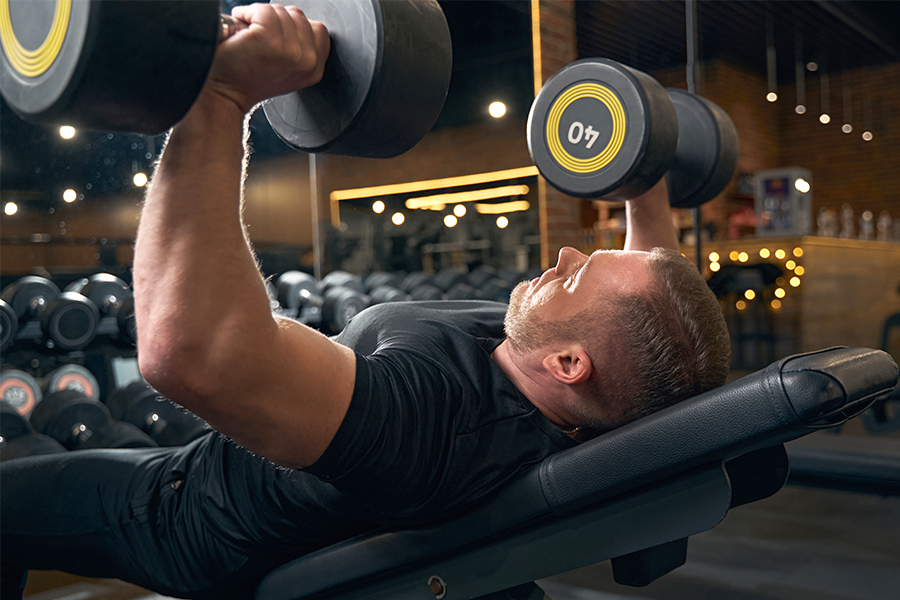
The Seated Incline Dumbbell Side Lateral Raise, also called a deltoid raise, uses a bench and weights to perform this workout.
The Seated Incline Dumbbell Side Lateral Raise is a versatile exercise that anyone aiming to strengthen their shoulder muscles can perform at home with a simple dumbbell set.
By practicing this movement regularly, you can achieve better muscle definition and improved posture without even going to the gym.
How to Perform Seated Incline Dumbbell Side Lateral Raise
- Sit down on the bench with your back against the backrest.
- Hold the dumbbells hanging down to the sides, keeping your elbows slightly bent.
- Raise the dumbbells to shoulder height, keeping your arms straight.
- Hold the raised position and then lower the dumbbells to the starting position.
- Perform the desired repetitions.
2. Standing Landmine Lateral Raise
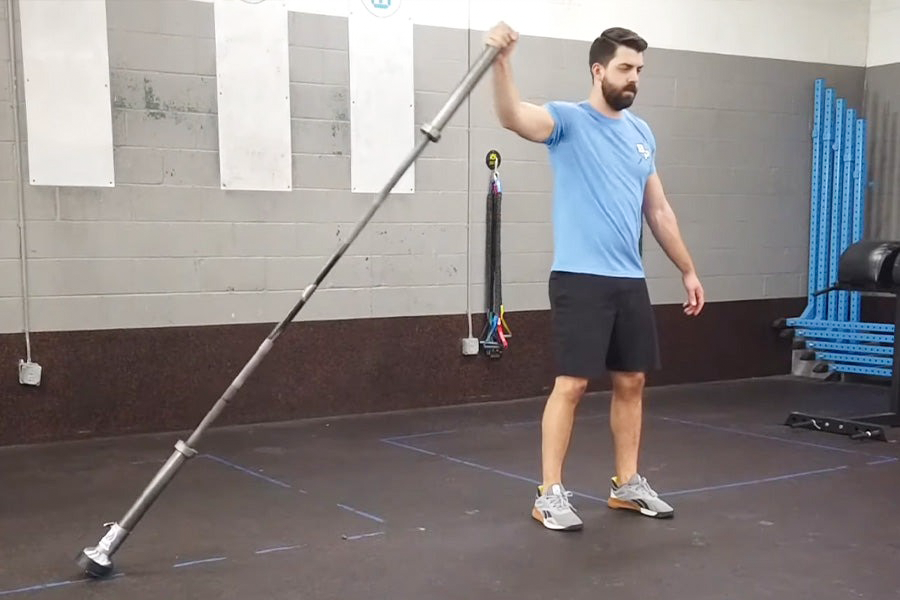
The Standing Landmine Lateral Raise is a variation of the lateral delt raise that uses a landmine attachment on a barbell to perform the movement.
The movements in the Standing Landmine Lateral Raise mimic other lifting patterns that improve overall functionality and strength. This exercise also enhances coordination between the upper and lower body, helping you build balance, control, and stability throughout your entire kinetic chain.
How to Perform Standing Landmine Lateral Raise
- Stand with the barbell positioned perpendicular to your body.
- Grab one end of the barbell with the hand closest to it.
- Raise your arm upward and slightly outward until it reaches shoulder height.
- Pause briefly at the top, then slowly lower the barbell back to the starting position.
- Perform the desired number of repetitions before switching arms.
3. Standing Single Arm Behind Back Cable Lateral Raise
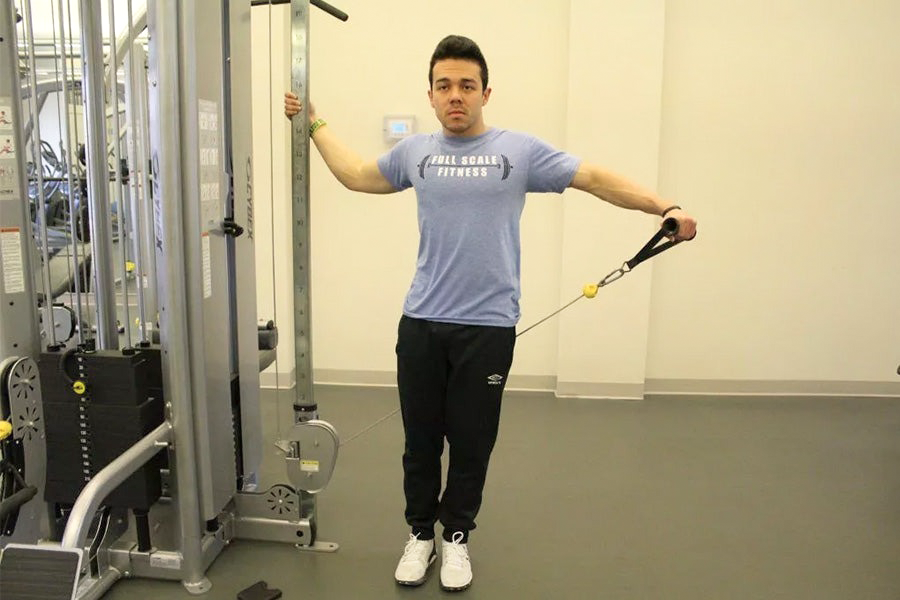
The Standing Single Arm Behind Back Cable Lateral Raise is a variation of the lateral raise that uses a cable machine to provide constant tension throughout the movement. Unlike free weights, it maintains consistent resistance, making it highly effective for targeting the lateral deltoid muscles.
This exercise also helps stabilize the shoulders and engage the core while improving muscle control and balance. It’s an excellent option for building strength evenly across both sides of the body.
How to Perform Standing Single Arm Behind Back Cable Lateral Raise
- Attach the desired weight to the low pulley of the cable machine.
- Stand with your left side facing the cable machine, feet shoulder-width apart.
- Ensure the cable and handle are positioned behind you. Grab the handle with your right hand and lift it toward your shoulder.
- Pause briefly at the top, then slowly return to the starting position.
- Repeat the desired number of reps before switching sides.
4. Seated Dumbbell Rear Delt Lateral Raise
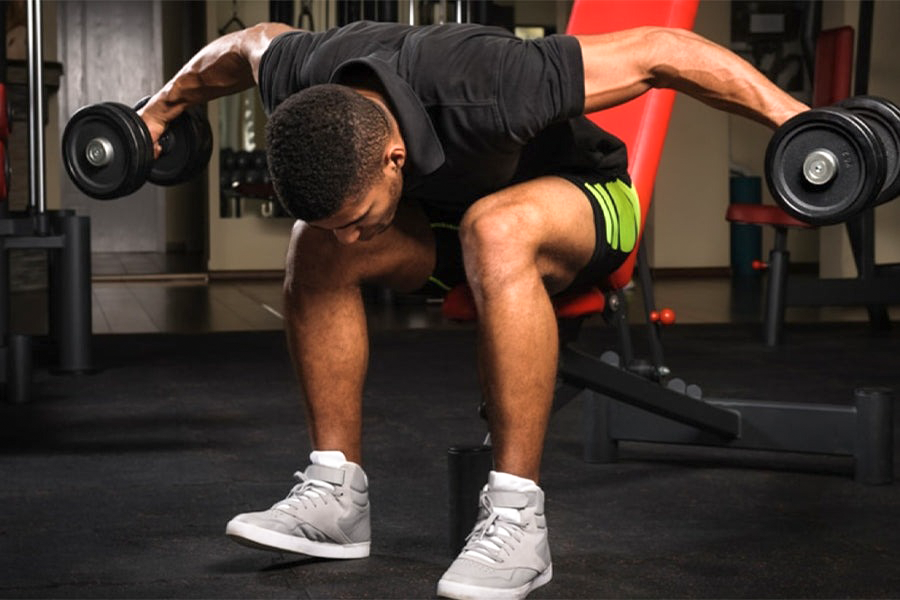
The Seated Dumbbell Rear Delt Lateral Raise uses a bench to target the posterior deltoid muscles and strengthen your shoulders through controlled movement.
This exercise helps improve posture and upper-body stability by strengthening the rear deltoids and supporting muscles. It’s a great way to develop shoulder balance and enhance everyday movements like lifting and pulling.
How to Perform Seated Dumbbell Rear Delt Lateral Raise
- Sit on the bench, slightly leaning forward.
- Hold dumbbells in both hands with palms facing each other.
- Lift the dumbbells to your sides simultaneously, keeping your arms straight.
- Slowly return to the starting position.
- Repeat for the desired number of reps.
5. Seated Machine Side Lateral Raises
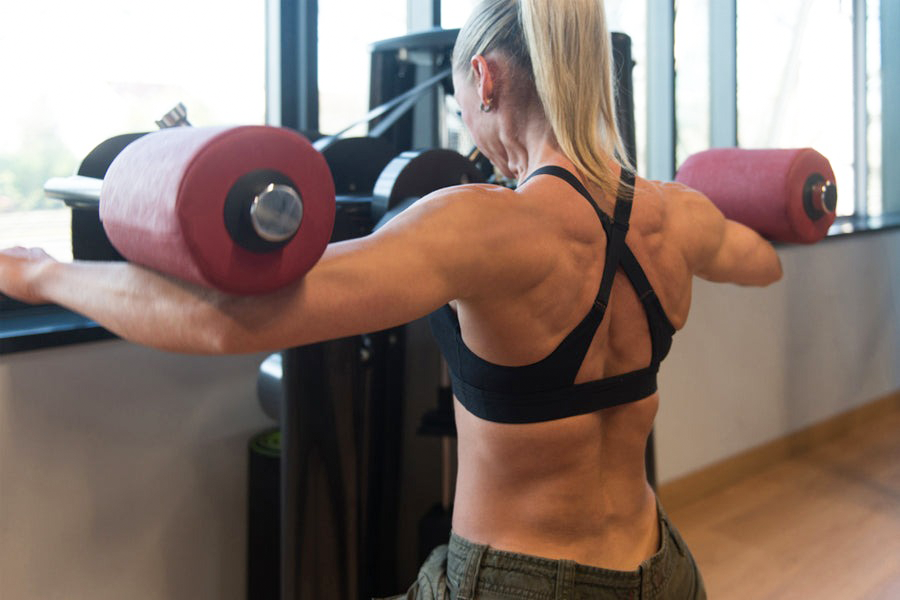
The Seated Machine Side Lateral Raises are performed on a lateral raise machine to intensify shoulder engagement using controlled, isolated movement.
This variation enhances shoulder stability, strength, and mobility. It’s also ideal for reducing the risk of injury and overcoming training plateaus by providing steady resistance throughout the motion.
How to Perform Seated Machine Side Lateral Raises
- Sit on the lateral raise machine and select your desired weight.
- Extend your arms and grab the handles, resting them lightly on the pads.
- Keep your core engaged and back straight.
- Push the weight until your arms are parallel to the ground.
- Slowly return to the starting position.
6. Bent Over Rear Delt Lateral Raise
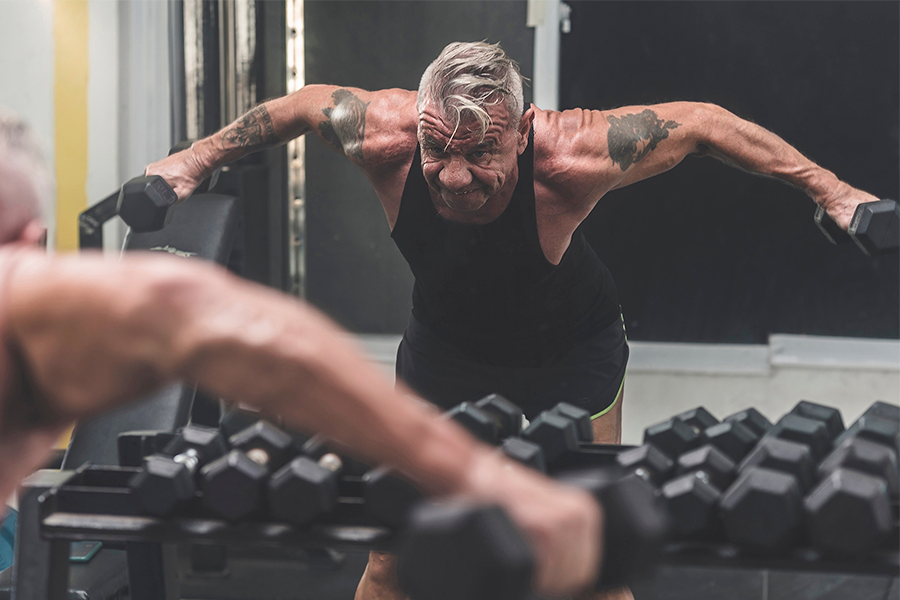
The Bent Over Rear Delt Lateral Raise, also known as the bent-over lateral raise, is a low-intensity exercise that targets the rear deltoid muscles for better posture and shoulder strength.
It can be performed with dumbbells, resistance bands, or cables, helping you build well-rounded shoulders and prevent muscle imbalances.
How to Perform Bent Over Rear Delt Lateral Raise
- Stand with your feet shoulder-width apart.
- Slightly hinge forward at your hips, keeping your spine neutral.
- Hold dumbbells in both hands with palms facing each other.
- Lift the dumbbells to your sides until they reach shoulder level.
- Slowly lower back to the starting position and repeat.
7. Seated Dumbbell Lateral Raise
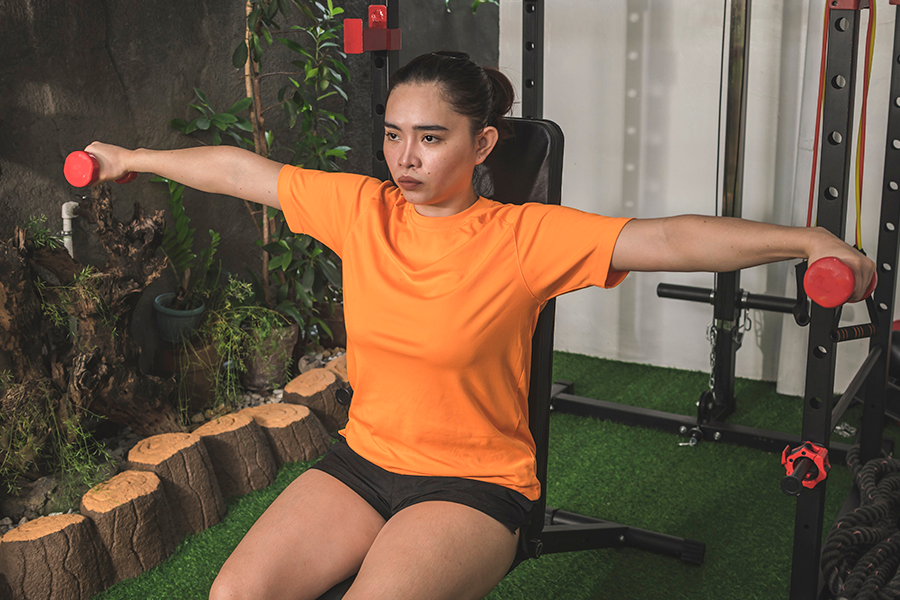
The Seated Dumbbell Lateral Raise is similar to the rear dumbbell lateral raise, except you remain upright rather than leaning forward. It primarily targets the side deltoids for broader, more stable shoulders.
This movement helps shape the shoulders and improve upper-body symmetry, contributing to a stronger and more defined physique.
How to Perform Seated Dumbbell Lateral Raise
- Sit on the bench with your feet shoulder-width apart.
- Hold dumbbells in both hands with palms facing each other.
- Lift the dumbbells to your sides, keeping your back straight and elbows slightly bent.
- Pause briefly at shoulder height, then slowly return to the starting position.
8. Standing Banded Lateral Raise
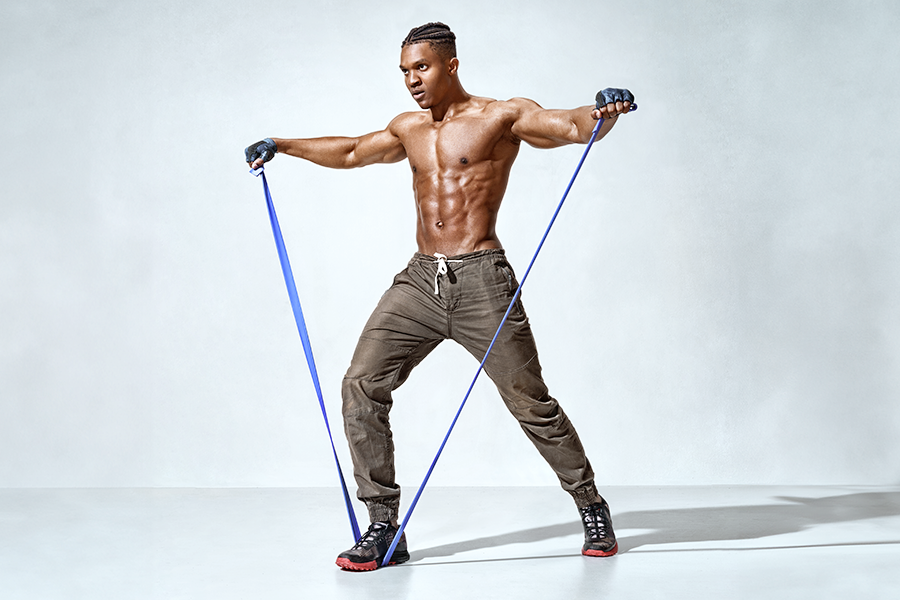
The Standing Banded Lateral Raise is a joint-friendly exercise performed with resistance bands to increase shoulder activation without heavy loads. It allows you to easily adjust resistance by changing your grip or stance.
This movement boosts shoulder growth and stability while minimizing joint strain, making it ideal for both home and gym workouts.
How to Perform Standing Banded Lateral Raise
- Stand in the middle of the resistance band with both feet.
- Hold both ends of the band with elbows slightly bent.
- Pull the band upward toward your shoulders while keeping your back straight.
- Pause for a moment when your arms are parallel to the ground.
- Slowly return to the starting position.
Lateral Raise Tips
- Focus on Stretch and Contraction: Perform each rep through the full range of motion, emphasizing the stretch at the bottom and the squeeze at the top to maximize shoulder engagement and muscle growth.
- Control Your Tempo: Keep the movement slow and deliberate to maintain constant tension on your delts. Avoid swinging the weights or using momentum; precision builds results.
- Maintain Proper Arm Alignment: Ensure your elbows stay slightly higher than your wrists throughout the movement. This alignment keeps the tension on your lateral delts and prevents shoulder strain.
- Keep Wrists Neutral: Maintain a slight inward tilt in your wrists while lifting to stabilize your grip and direct effort toward the shoulders instead of your forearms.
- Don’t Rest Between Reps: Avoid letting the dumbbells touch your body at the bottom of each rep. Keeping tension consistent enhances muscle endurance and overall effectiveness.
- Engage Your Core: Keep your torso stable and core tight during the movement. Avoid leaning or tilting, as this reduces focus from your shoulder muscles.
- Prioritize Form Over Weight: Use lighter dumbbells if needed. Perfecting your form is more important than lifting heavy; gradually increase the load as your control and strength improve.
Conclusion
The dumbbell lateral raise and its variations are among the most effective exercises for building round, strong, and well-defined shoulders. By mastering proper form and incorporating different angles, you can target every part of your deltoids for complete shoulder development. Remember to focus on controlled movements, steady breathing, and progressive overload to get the best results.
Reading List
What are Deltoid Muscles? 6 Best Shoulder Isolation Exercises for Men to Get Bigger Deltoids
4-Week Shoulder Shocker Workout to Ignite Muscle Growth
5 Kettlebell Shoulder Workouts That Build Shoulder Strength & Stability
ARMergency: How to Get the Killer Arms You've Always Wanted
How to Get Bigger Arms in 30 Days: Follow These 5 Easy Steps




